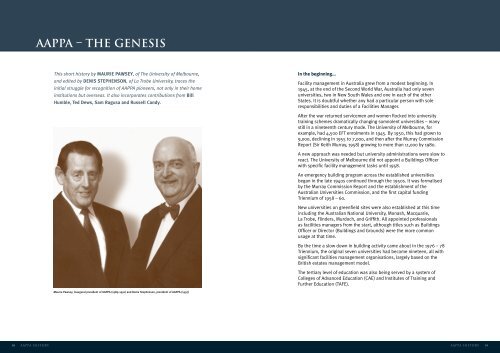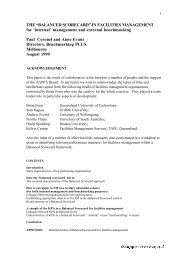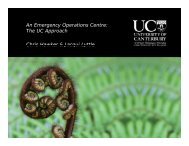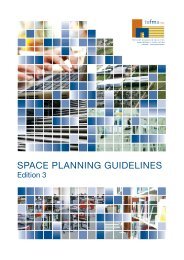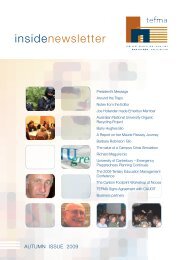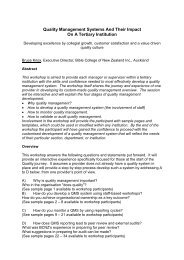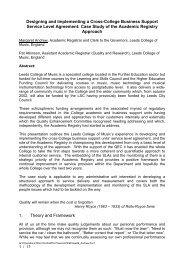aappa history - Tertiary Education Facilities Management Association
aappa history - Tertiary Education Facilities Management Association
aappa history - Tertiary Education Facilities Management Association
You also want an ePaper? Increase the reach of your titles
YUMPU automatically turns print PDFs into web optimized ePapers that Google loves.
18 AAPPA HISTORY<br />
AAPPA – THE GENESIS<br />
This short <strong>history</strong> by MAURIE PAWSEY, of The University of Melbourne,<br />
and edited by DENIS STEPHENSON, of La Trobe University, traces the<br />
initial struggle for recognition of AAPPA pioneers, not only in their home<br />
institutions but overseas. It also incorporates contributions from Bill<br />
Humble, Ted Dews, Sam Ragusa and Russell Candy.<br />
Maurie Pawsey, inaugural president of AAPPA (1989-1991) and Denis Stephenson, president of AAPPA (1997)<br />
In the beginning…<br />
Facility management in Australia grew from a modest beginning. In<br />
1945, at the end of the Second World War, Australia had only seven<br />
universities, two in New South Wales and one in each of the other<br />
States. It is doubtful whether any had a particular person with sole<br />
responsibilities and duties of a <strong>Facilities</strong> Manager.<br />
After the war returned servicemen and women flocked into university<br />
training schemes dramatically changing somnolent universities – many<br />
still in a nineteenth century mode. The University of Melbourne, for<br />
example, had 4,500 EFT enrolments in 1945. By 1950, this had grown to<br />
9,000, declining in 1955 to 7,000, and then after the Murray Commission<br />
Report (Sir Keith Murray, 1958) growing to more than 11,000 by 1980.<br />
A new approach was needed but university administrations were slow to<br />
react. The University of Melbourne did not appoint a Buildings Officer<br />
with specific facility management tasks until 1958.<br />
An emergency building program across the established universities<br />
began in the late 1940s continued through the 1950s. It was formalised<br />
by the Murray Commission Report and the establishment of the<br />
Australian Universities Commission, and the first capital funding<br />
Triennium of 1958 – 60.<br />
New universities on greenfield sites were also established at this time<br />
including the Australian National University, Monash, Macquarie,<br />
La Trobe, Flinders, Murdoch, and Griffith. All appointed professionals<br />
as facilities managers from the start, although titles such as Buildings<br />
Officer or Director (Buildings and Grounds) were the more common<br />
usage at that time.<br />
By the time a slow down in building activity came about in the 1976 – 78<br />
Triennium, the original seven universities had become nineteen, all with<br />
significant facilities management organisations, largely based on the<br />
British estates management model.<br />
The tertiary level of education was also being served by a system of<br />
Colleges of Advanced <strong>Education</strong> (CAE) and Institutes of Training and<br />
Further <strong>Education</strong> (TAFE).<br />
AAPPA HISTORY 19


